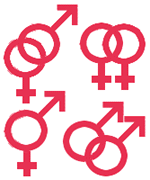Our polarized academic world, combining weak understandings of sexual bio-psychology with politics.
I juxtapose this piece from The New York Times, “Warning: The Literary Canon Could Make Students Squirm,” with this report from Britain’s The Telegraph, “‘Paedophilia is natural and normal for males’ How some university academics make the case for paedophiles at summer conferences.” 
A. One group of academics says: Many are traumatized by awful sexual experiences, so we must forbid environmental triggers. (“Nothing goes.”)
B. Another group of academics says: Desiring sex with children is biologically natural and normal, so we must decriminalize it. (“Anything goes.”)
Imagine if we invited both groups to a conference and locked them in a seminar room together.
Ick. I just triggered some unpleasant emotions in myself.
The whole trigger warning trend needs to be taken out and shot.
Consider the Oberlin College claim quoted in the first story, “Realize that all violence is traumatic, and that your students have lives before and outside your classroom, experiences you may not expect or understand.”
I wonder if it occurred to the authors of that boilerplate that it works the other way around, as well. How many people realize that faculty have lives before and outside the workplace, experiences that may not be expected or widely understood by students or administrators?
Sometimes our students say things that require trigger warnings from them. But if I teach 2-3 classes a day of 10-30 students, and just half of them say things that trigger me, we’re talking about the need for dozens of trigger warnings a day. So while the trigger-warners are micro-managing our classrooms, perhaps they could spare a moment to explain how anyone is to manage to have a conversation under such conditions?
Does anyone know of a peer reviewed literature in psychology that addresses the science behind the whole trigger warning trend? I’d hate to think that there isn’t one. Granted, DSM-5 makes implicit reference “intrusion symptoms associated with the traumatic event(s)” (B1-5), but DSM-5 is itself disputable, and the DSM-5 discussion doesn’t, as a whole, fit the way “trigger warning” is now being used. I don’t think that discussions about “trigger warnings” should even be considered until such a literature is cited.
Diagnosing PTSD is difficult enough as it is. It’s preposterous to think that higher ed policy is being set on the basis of pseudo-clinical spinoffs of a diagnostic category that’s already too loosely applied. But if that’s the case, it’s time to inflict some real trauma on this whole trend. It sounds conspiratorial, but we’re courting the possibility of curtailments of free speech and academic freedom via Section 503 ADA compliance. If trigger warnings become construed as “reasonable accommodations” under section 503, academic freedom is over.
A typo: I meant to say, “Granted DSM-5 makes implicit reference to trigger warnings via “intrusion symptoms…”
This goes to show how absurd academia has become. On one end, women are being raped and traumatized all across campuses. We must protect women(by treating them like children who lack agency), yet academics promote the raping of children, and any other amoral activities!?!?!?!?! This is madness. Why would anyone want to work in the academy? At least in the United States.